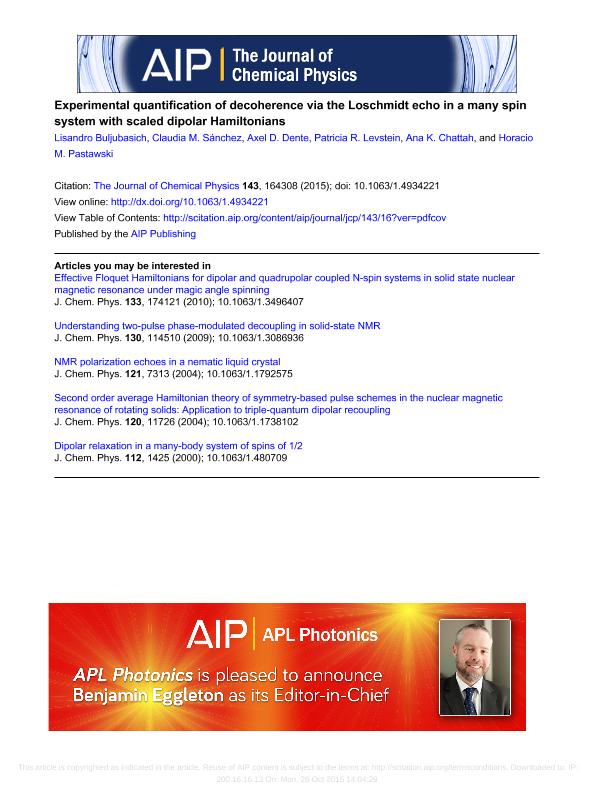Mostrar el registro sencillo del ítem
dc.contributor.author
Buljubasich Gentiletti, Lisandro

dc.contributor.author
Sánchez, Claudia Marina

dc.contributor.author
Dente, Axel Damián

dc.contributor.author
Levstein, Patricia Rebeca

dc.contributor.author
Chattah, Ana Karina

dc.contributor.author
Pastawski, Horacio Miguel

dc.date.available
2023-01-30T14:05:57Z
dc.date.issued
2015-10
dc.identifier.citation
Buljubasich Gentiletti, Lisandro; Sánchez, Claudia Marina; Dente, Axel Damián; Levstein, Patricia Rebeca; Chattah, Ana Karina; et al.; Experimental quantification of decoherence via the Loschmidt echo in a many spin system with scaled dipolar Hamiltonians; American Institute of Physics; Journal of Chemical Physics; 143; 16; 10-2015; 164308-164308
dc.identifier.issn
0021-9606
dc.identifier.uri
http://hdl.handle.net/11336/186093
dc.description.abstract
We performed Loschmidt echo nuclear magnetic resonance experiments to study decoherence under a scaled dipolar Hamiltonian by means of a symmetrical time-reversal pulse sequence denominated Proportionally Refocused Loschmidt (PRL) echo. The many-spin system represented by the protons in polycrystalline adamantane evolves through two steps of evolution characterized by the secular part of the dipolar Hamiltonian, scaled down with a factor |k| and opposite signs. The scaling factor can be varied continuously from 0 to 1/2, giving access to a range of complexity in the dynamics. The experimental results for the Loschmidt echoes showed a spreading of the decay rates that correlate directly to the scaling factors |k|, giving evidence that the decoherence is partially governed by the coherent dynamics. The average Hamiltonian theory was applied to give an insight into the spin dynamics during the pulse sequence. The calculations were performed for every single radio frequency block in contrast to the most widely used form. The first order of the average Hamiltonian numerically computed for an 8-spin system showed decay rates that progressively decrease as the secular dipolar Hamiltonian becomes weaker. Notably, the first order Hamiltonian term neglected by conventional calculations yielded an explanation for the ordering of the experimental decoherence rates. However, there is a strong overall decoherence observed in the experiments which is not reflected by the theoretical results. The fact that the non-inverted terms do not account for this effect is a challenging topic. A number of experiments to further explore the relation of the complete Hamiltonian with this dominant decoherence rate are proposed.
dc.format
application/pdf
dc.language.iso
eng
dc.publisher
American Institute of Physics

dc.rights
info:eu-repo/semantics/openAccess
dc.rights.uri
https://creativecommons.org/licenses/by-nc-sa/2.5/ar/
dc.subject
NUCLEAR MAGNETIC RESONANCE
dc.subject
QUANTUM SYSTEMS
dc.subject
DECOHERENCE
dc.subject
SPIN DYNAMICS
dc.subject.classification
Física Atómica, Molecular y Química

dc.subject.classification
Ciencias Físicas

dc.subject.classification
CIENCIAS NATURALES Y EXACTAS

dc.title
Experimental quantification of decoherence via the Loschmidt echo in a many spin system with scaled dipolar Hamiltonians
dc.type
info:eu-repo/semantics/article
dc.type
info:ar-repo/semantics/artículo
dc.type
info:eu-repo/semantics/publishedVersion
dc.date.updated
2023-01-26T17:33:39Z
dc.journal.volume
143
dc.journal.number
16
dc.journal.pagination
164308-164308
dc.journal.pais
Estados Unidos

dc.journal.ciudad
New York
dc.description.fil
Fil: Buljubasich Gentiletti, Lisandro. Universidad Nacional de Córdoba. Facultad de Matemática, Astronomía y Física; Argentina. Consejo Nacional de Investigaciones Científicas y Técnicas. Centro Científico Tecnológico Conicet - Córdoba. Instituto de Física Enrique Gaviola. Universidad Nacional de Córdoba. Instituto de Física Enrique Gaviola; Argentina
dc.description.fil
Fil: Sánchez, Claudia Marina. Universidad Nacional de Córdoba. Facultad de Matemática, Astronomía y Física; Argentina
dc.description.fil
Fil: Dente, Axel Damián. Universidad Nacional de Córdoba. Facultad de Matemática, Astronomía y Física; Argentina. Consejo Nacional de Investigaciones Científicas y Técnicas. Centro Científico Tecnológico Conicet - Córdoba. Instituto de Física Enrique Gaviola. Universidad Nacional de Córdoba. Instituto de Física Enrique Gaviola; Argentina
dc.description.fil
Fil: Levstein, Patricia Rebeca. Universidad Nacional de Córdoba. Facultad de Matemática, Astronomía y Física; Argentina. Consejo Nacional de Investigaciones Científicas y Técnicas. Centro Científico Tecnológico Conicet - Córdoba. Instituto de Física Enrique Gaviola. Universidad Nacional de Córdoba. Instituto de Física Enrique Gaviola; Argentina
dc.description.fil
Fil: Chattah, Ana Karina. Consejo Nacional de Investigaciones Científicas y Técnicas. Centro Científico Tecnológico Conicet - Córdoba. Instituto de Física Enrique Gaviola. Universidad Nacional de Córdoba. Instituto de Física Enrique Gaviola; Argentina. Universidad Nacional de Córdoba. Facultad de Matemática, Astronomía y Física; Argentina
dc.description.fil
Fil: Pastawski, Horacio Miguel. Consejo Nacional de Investigaciones Científicas y Técnicas. Centro Científico Tecnológico Conicet - Córdoba. Instituto de Física Enrique Gaviola. Universidad Nacional de Córdoba. Instituto de Física Enrique Gaviola; Argentina
dc.journal.title
Journal of Chemical Physics

dc.relation.alternativeid
info:eu-repo/semantics/altIdentifier/doi/http://dx.doi.org/10.1063/1.4934221
Archivos asociados
